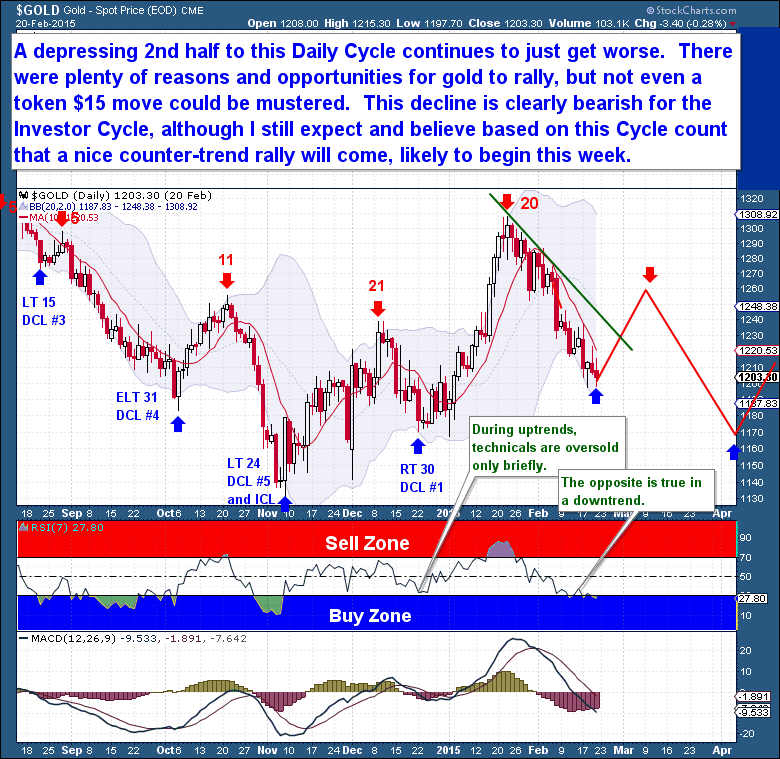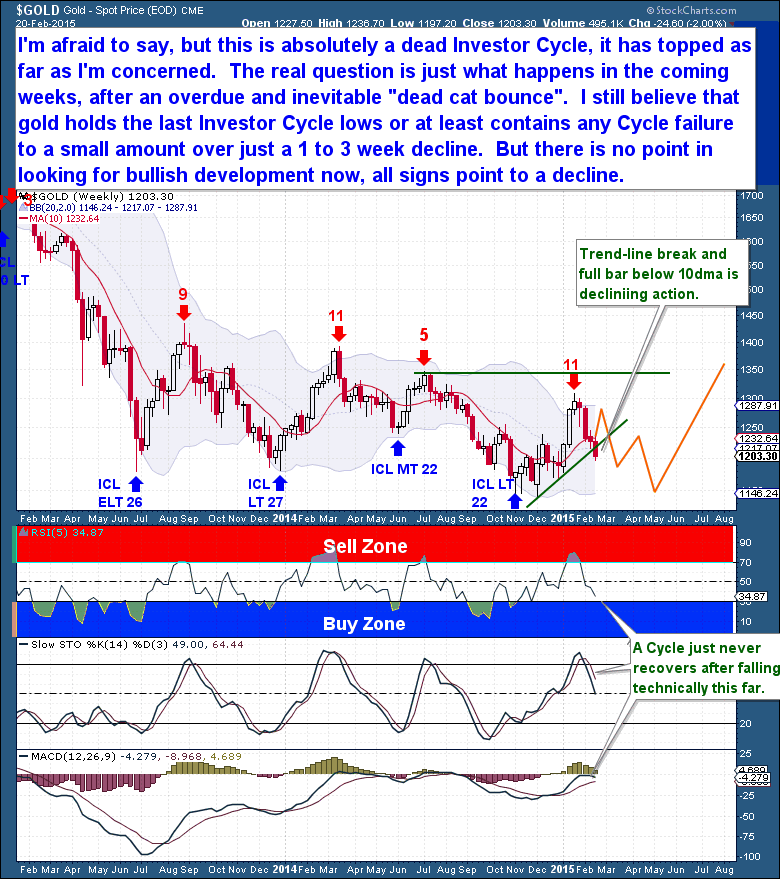The Gold market appears to be in reverse gear at present. It’s at fresh 6 week lows with a 2nd Daily Cycle that continues to wind lower, and is showing nothing that’s at all positive. Gold is trading very lethargically, and is uninteresting from most perspectives.
Assets move higher or lower in direct relation to the sentiment of traders and investors. And sentiment swings like a pendulum, from bullish to bearish and then back again. Sentiment is the primary driver of demand, with greater buyer engagement – both in numbers and enthusiasm – required to drive prices higher. Unfortunately for Gold bulls, it appears that the sentiment pendulum has already peaked, and is heading back toward bearish lows. We see this clearly in the COT reports, with traders continuing to shift from net Long to net Short positions. The report’s actual survey data confirms that sentiment for the current Investor Cycle has topped, and is now in decline.
Ultimately, price action rules. In this case, with the current Daily Cycle having declined for 22 days (and counting), Gold’s price shows clear confirmation of an Investor Cycle decline. Bullish Cycles generally contain declines of no more than 10 days.
Headlines don’t always drive asset prices, but if Gold were inclined to move higher, last week’s sound bites around both a potential Greek exit and a breakdown of the Ukraine ceasefire offered plenty of fuel for it. Instead, Gold continued moving lower without a hint of strength. Given the geopolitical backdrop, Gold’s lack of upside movement speaks volumes about its underlying demand.

On the Investor Cycle timeframe, the current 4 week decline also creates problems for bulls. There is no way to sugar coat it: the action has been downright bearish. In my opinion the evidence clearly shows that the current Investor Cycle has topped and is on the way to a Investor Cycle Low.
From a review of past Cycles, especially those of the past 4 years, it’s clear that the week 11 high is almost certainly the top of the current Investor Cycle. Having price fall through the weekly trend-line is one issue, but the firm close below the 10 week moving average creates even more of a concern. In addition, an Investor Cycle in an uptrend rarely sees price spend an entire week below the 10 wma, but that’s what happened to Gold this week.

With Gold now 15 weeks into the current Investor Cycle and with a 10 wma that has turned lower, it’s clear that the current Investor Cycle is in decline and on its way to a trough. At this point, the evidence is conclusive, so only an outlying Cycle development would shift our outlook. Traders need to be aware that an oversold Daily Cycle rally should come this week, but that is an opportunity to sell on strength and capture the larger move lower over the coming months.
The Financial Tap publishes two member reports per week, a weekly premium report and a midweek market update report. The reports cover the movements and trading opportunities of the Gold, S&P, Oil, $USD, US Bond’s, and Natural Gas Cycles. Along with these reports, members enjoy access to two different portfolios and trade alerts. Both portfolios trade on varying time-frames (from days, weeks, to months), there is a portfolio to suit all member preferences.
You’re just 1 minute away from profitable trades! please visit: https://thefinancialtap.com
Feel free to share this post via the below social media avenues.
Keep On Rolling
/in Premium /by Bob LoukasYou don’t have access to view this content
A Gold Trading Idea
/in Public /by Bob LoukasYesterday’s FOMC was bullish for most assets, as the FED indicated it was not ready to beginning raising rates. The FED’s ZIRP policy, designed primarily to encourage lending and speculative asset purchases, is clearly here to stay for a while longer. But for gold, this policy has done little for it over the past 3 years, as speculative money is much more concerned with chasing equity and bond markets higher.
Which is why we should be careful here and to avoid reading into a solitary $20 move on a bullish FOMC day. For starters, the dollar fell by a massive amount, this alone accounted for much of the gold increase. But also more importantly, gold was extremely oversold, being down for 12 of the 13 preceding sessions. Therefore, there was an expectation for gold to move higher yesterday, the asset was setup and ready to rally on almost any excuse.
As I outlined with much more detail (premium report) this past weekend, the Cycle timing is simply not right for a sustained rally. A combination of (early) Weekly Cycle timing, gold sentiment, and the COT report, all show evidence to support an Investor Cycle Low that is just a shy too early. I also cautioned members to be on the lookout for a “suckers rally”, and not to confuse it with a new Investor Cycle rally.
So as yesterday’s move higher was expected, it is also likely that gold will continue higher for the coming days and the action to appear convincing. However, as gold recently entered into the final chapter of this Investor Cycle, it is unlikely to have the strength required to get beyond $1,200. Traders should be on the lookout for a peak around the $1,180-$1,200 from which they could short the gold Cycle, because the decline from that peak should be of the “capitulation variety”. The good news is that if we’re incorrect on this Cycle outlook, then gold only needs to exceed $1,223 (prior Cycle high) to prove us wrong.
The Financial Tap publishes two member reports per week, a weekly premium report and a midweek market update report. The reports cover the movements and trading opportunities of the Gold, S&P, Oil, $USD, US Bond’s, and Natural Gas Cycles. Along with these reports, members enjoy access to two different portfolios and trade alerts. Both portfolios trade on varying time-frames (from days, weeks, to months), there is a portfolio to suit all member preferences.
You’re just 1 minute away from profitable trades! please visit: https://thefinancialtap.com
Feel free to share this post via the below social media avenues.
Midweek Market Update – March 18th
/in Premium /by Bob LoukasYou don’t have access to view this content
Has the Market Met its Match
/in Premium /by Bob LoukasYou don’t have access to view this content
Midweek Market Update – March 11th
/in Premium /by Bob LoukasYou don’t have access to view this content
Still too many Bond Bears
/in Premium /by Bob LoukasYou don’t have access to view this content
Midweek Market Update – March 4th
/in Premium /by Bob LoukasYou don’t have access to view this content
Irrational Complacency
/in Premium /by Bob LoukasYou don’t have access to view this content
Midweek Market Update – Feb 25th
/in Premium /by Bob LoukasYou don’t have access to view this content
Gold Just Needs More Time
/in Public /by Bob LoukasThe Gold market appears to be in reverse gear at present. It’s at fresh 6 week lows with a 2nd Daily Cycle that continues to wind lower, and is showing nothing that’s at all positive. Gold is trading very lethargically, and is uninteresting from most perspectives.
Assets move higher or lower in direct relation to the sentiment of traders and investors. And sentiment swings like a pendulum, from bullish to bearish and then back again. Sentiment is the primary driver of demand, with greater buyer engagement – both in numbers and enthusiasm – required to drive prices higher. Unfortunately for Gold bulls, it appears that the sentiment pendulum has already peaked, and is heading back toward bearish lows. We see this clearly in the COT reports, with traders continuing to shift from net Long to net Short positions. The report’s actual survey data confirms that sentiment for the current Investor Cycle has topped, and is now in decline.
Ultimately, price action rules. In this case, with the current Daily Cycle having declined for 22 days (and counting), Gold’s price shows clear confirmation of an Investor Cycle decline. Bullish Cycles generally contain declines of no more than 10 days.
Headlines don’t always drive asset prices, but if Gold were inclined to move higher, last week’s sound bites around both a potential Greek exit and a breakdown of the Ukraine ceasefire offered plenty of fuel for it. Instead, Gold continued moving lower without a hint of strength. Given the geopolitical backdrop, Gold’s lack of upside movement speaks volumes about its underlying demand.
On the Investor Cycle timeframe, the current 4 week decline also creates problems for bulls. There is no way to sugar coat it: the action has been downright bearish. In my opinion the evidence clearly shows that the current Investor Cycle has topped and is on the way to a Investor Cycle Low.
From a review of past Cycles, especially those of the past 4 years, it’s clear that the week 11 high is almost certainly the top of the current Investor Cycle. Having price fall through the weekly trend-line is one issue, but the firm close below the 10 week moving average creates even more of a concern. In addition, an Investor Cycle in an uptrend rarely sees price spend an entire week below the 10 wma, but that’s what happened to Gold this week.
With Gold now 15 weeks into the current Investor Cycle and with a 10 wma that has turned lower, it’s clear that the current Investor Cycle is in decline and on its way to a trough. At this point, the evidence is conclusive, so only an outlying Cycle development would shift our outlook. Traders need to be aware that an oversold Daily Cycle rally should come this week, but that is an opportunity to sell on strength and capture the larger move lower over the coming months.
The Financial Tap publishes two member reports per week, a weekly premium report and a midweek market update report. The reports cover the movements and trading opportunities of the Gold, S&P, Oil, $USD, US Bond’s, and Natural Gas Cycles. Along with these reports, members enjoy access to two different portfolios and trade alerts. Both portfolios trade on varying time-frames (from days, weeks, to months), there is a portfolio to suit all member preferences.
You’re just 1 minute away from profitable trades! please visit: https://thefinancialtap.com
Feel free to share this post via the below social media avenues.